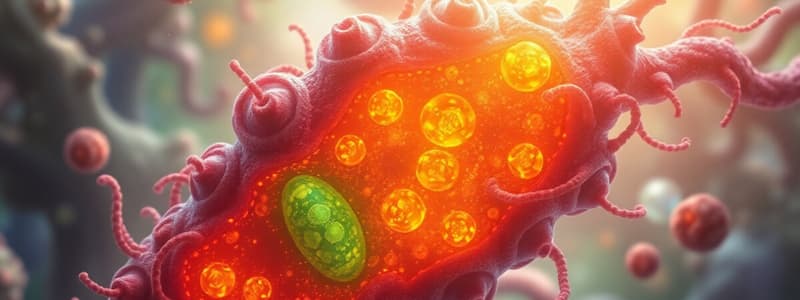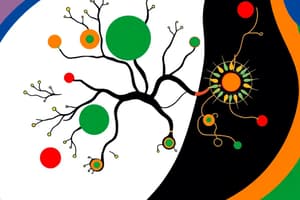Podcast
Questions and Answers
What is the primary function of insulin in the body?
What is the primary function of insulin in the body?
- Lower glucose levels (correct)
- Increase glucose levels
- Regulate temperature
- Facilitate digestion
All living things respond to stimuli.
All living things respond to stimuli.
True (A)
What molecule carries the genetic information in living organisms?
What molecule carries the genetic information in living organisms?
Deoxyribonucleic acid (DNA)
When the body temperature increases, the body cools itself down by __________.
When the body temperature increases, the body cools itself down by __________.
Match the type of adaptation to its definition:
Match the type of adaptation to its definition:
What is thigmotaxis?
What is thigmotaxis?
All organisms start their development from multiple cells.
All organisms start their development from multiple cells.
What are inherited changes that improve survival called?
What are inherited changes that improve survival called?
The ability of plants to grow towards light is called __________.
The ability of plants to grow towards light is called __________.
Which of the following is an example of a physical adaptation?
Which of the following is an example of a physical adaptation?
Which of the following is NOT a characteristic of living organisms?
Which of the following is NOT a characteristic of living organisms?
Viruses are considered living organisms because they can reproduce.
Viruses are considered living organisms because they can reproduce.
What is the term used to describe the stable internal environment that living organisms maintain?
What is the term used to describe the stable internal environment that living organisms maintain?
All living things must maintain a stable internal environment known as __________.
All living things must maintain a stable internal environment known as __________.
Match the following living organisms with their characteristics:
Match the following living organisms with their characteristics:
What do we call the chemicals reactions that all living organisms perform to obtain and use energy?
What do we call the chemicals reactions that all living organisms perform to obtain and use energy?
All living organisms can perform both photosynthesis and respiration.
All living organisms can perform both photosynthesis and respiration.
Name one example of an abiotic factor.
Name one example of an abiotic factor.
An organism that consists of a single cell is described as __________.
An organism that consists of a single cell is described as __________.
Which of the following is an example of a biotic factor?
Which of the following is an example of a biotic factor?
Flashcards are hidden until you start studying
Study Notes
Biology: The Study of Life
- Biology is the study of life.
- Living organisms are called biotic factors
- Nonliving things are called abiotic factors.
- Viruses are not considered living organisms because they cannot reproduce on their own. They need to take over a host cell to reproduce.
Seven Characteristics of Life:
- Cellular Organization: All living things are made of cells.
- Reproduction: The ability to produce offspring.
- Metabolism: Chemical reactions that occur within an organism to sustain life, requiring energy.
- Homeostasis: Maintaining a stable internal environment.
- Heredity: Passing on traits to offspring through genes.
- Responsiveness: Responding to stimuli in the environment.
- Growth and Development: Increasing in size and maturing over time.
- Adaptations: Inherited traits that help a species survive.
Cellular Structure and Function
- Cells are the basic unit of life, capable of all life functions.
- Organisms can be unicellular (single-celled) or multicellular (many cells).
Reproduction
- Necessary for the survival of a species.
Metabolism
- Involves obtaining and using energy for life processes.
- Examples include: photosynthesis (plants using sunlight to make glucose) and breaking down food to obtain energy.
Homeostasis:
- Important for maintaining a stable internal environment in organisms.
- Examples:
- Regulating blood glucose levels.
- Removing waste products from the blood through urination.
- Cooling the body through sweating.
- Closing stomata in plants to prevent dehydration.
Heredity
- Passing on traits to offspring through genes.
- Genes are coded in DNA (deoxyribonucleic acid).
Responsiveness
- Reaction or response to stimuli.
- Examples:
- Phototropism (plants growing towards light).
- Phototaxis (organisms moving toward or away from light).
- Thigmotaxis (organisms responding to touch).
- Reflexes in animals to prevent harm.
Growth and Development
- All living things increase in size and mature over time.
- Multicellular organisms begin from a single cell and develop into specialized cells.
Adaptations
- Inherited traits that help species survive.
- Examples:
- Eyeballs adapting to different light conditions: round pupils for chasing prey, vertical slit pupils for ambush predators, horizontal pupils for prey animals.
- Behavioral adaptations: migration, hibernation, mating behaviors, communication, finding food.
- Physical adaptations: body parts, color and pattern, camouflage, mimicry.
Studying That Suits You
Use AI to generate personalized quizzes and flashcards to suit your learning preferences.




